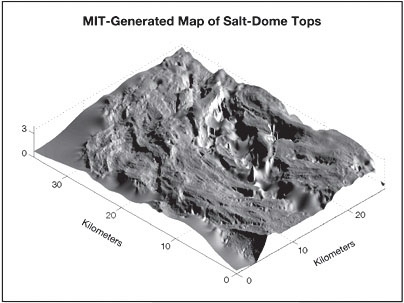Mathematical procedures developed at MIT may soon help energy companies locate new sources of oil many kilometers underground.
Working closely with teams at Shell International Exploration and Production, the MIT researchers have demonstrated the power of one of their procedures by mapping out an underground oil-trapping geological formation based on limited seismic data.
To keep up with the world's growing demand for oil, energy companies must drill deeper and look harder in increasingly complex geological structures. But locating such structures many kilometers beneath the Earth's surface is difficult, and getting it right is important. Companies can spend as much as $100 million drilling a single well -- a costly mistake if it comes up dry.
To find promising underground sites, companies collect seismic data by using air guns or explosives to send shock waves deep into the ground. How the waves are reflected by underground layers provides information that sophisticated signal-processing techniques can turn into 3-D images of the subsurface. But identifying promising geological structures within those images is difficult.
The Stochastic Systems Group (SSG) at MIT's Laboratory for Information and Decision Systems specializes in designing mathematical procedures, or algorithms, that can quickly analyze complex images. Could some of their algorithms be useful in the oil exploration business? Professor Alan S. Willsky, director of the SSG, and Shell researchers started a project to find out.
Obvious candidates were procedures for defining a continuous surface from a limited set of data points. As a first target, the researchers selected the task of mapping out "top salt," that is, the surface along the tops of contiguous salt domes. Salt domes form deep underground when heavy layers of sediment deposit on salt beds from ancient oceans. The salt extrudes upward like globules in a lava lamp, in the process tilting and blocking off sedimentary layers and creating traps where oil can accumulate.
To generate a map, industrial experts pick points in the onscreen images that they think may be the top salt, and the computer fills in the gaps. By changing their "picks," the experts produce multiple maps for consideration, each one covering several kilometers in length, width and relief. Generating those maps quickly is critical.
The MIT algorithms are well suited to the task. The key is how the different picks relate to one another. "There are statistical relationships between things that happen at different points in space," said Willsky, the Edwin Sibley Webster Professor of Electrical Engineering. "You don't expect properties of the rock at one point to be completely independent of the properties a meter away."
Given a set of picks, the MIT algorithms automatically define statistical relationships from one pick to the next and fill in the missing points based on those relationships. Moreover, they calculate the uncertainty associated with each generated point.
But identifying the top salt is only the beginning. The company also needs to see the shapes of geologic formations to guide their drilling. With a salt dome, for example, the company needs to drill into the adjacent sedimentary layers but not into the salt itself because it will contain no oil.
Again, the MIT researchers have algorithms that can help -- algorithms that they have been using to help medical researchers interpret data from MRIs and CT scans.
Key to the success of this research is constant interaction between the MIT and Shell researchers. "We don't just develop tools and throw them over the transom to Shell," said Willsky. "We're constantly looking over each other's shoulders" to find areas of mutual interest and potential benefit. Teaching each other about their separate areas of expertise is also critical. For Shell, the challenge is to understand MIT's "modern mathematical tools" well enough to build them into the company's existing analytical methods.
This research was funded by Shell International Exploration and Production through MIT's Computer Science and Artificial Intelligence Laboratory.
A version of this article appeared in MIT Tech Talk on May 17, 2006 (download PDF).






